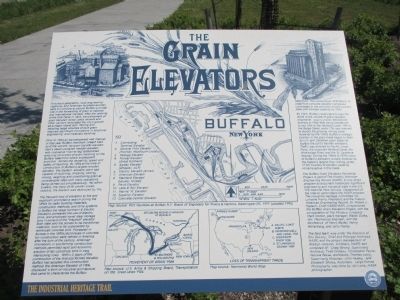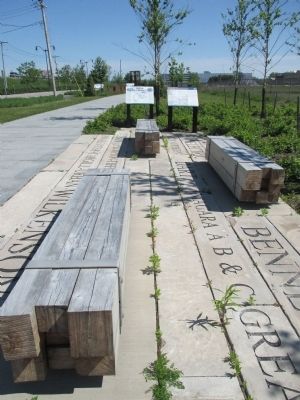First Ward in Buffalo in Erie County, New York — The American Northeast (Mid-Atlantic)
The Grain Elevators
The Industrial Heritage Trail
Prior to 1842 all transshipmen was manual. In that year Buffalo merchant Joseph Dart built the world's 1st grain transfer elevator. Dart's steam-powered wooden elevator, with innovative "marine leg," established enduring principles of grain handling on the Buffalo waterfront where subsequent evolution refined ther versatility, speed and safety of handling. By 1894, at the time of construction of Buffalo's largest wooden elevator, the Eastern elevator plant was capable of receiving, shipping, storing, mixing, weighing and conditioning grain at considerable rates with many operations being carried out simultaneously. Yet within 5 years, like many of its smaller predecessors, the Eastern was destroyed by fire.
The frequent loss of elevators to fire and explosion prompted a search during the 1890s for safer building materials, construction methods, and drive systems. In Buffalo the Great Northern & Electric Elevators pioneered the use of electric drive, and employed novel steel storage bins in pursuit of the "fireproof" elevator. Both steel and tile proved to be transitional materials, soon to be superseded by reinforced concrete bins. Pioneered in Eurpoe in the 1890s, techniques in concrete construction were refined in America after the turn of the century. American innovations in slip-forming construction methods permitted rapid and economic erection of tall cylindrical bins in long interlocking rows. Within 2 years of the construction of the first-slip formed elevator, Buffalo had adopted this construction method; the American Elevator of 1906 displayed a form of industrial architecture that came to characterize the Buffalo waterfront. The construction of Buffalo's 14 waterfront concrete elevator complexes culminated in the provision of 60m bushels peak storage capacity by 1943.
By 1924, Buffalo could claim to lead the world in the volume of grain handled; shipments reached over 300,000,000 bushels in 1928, 48% being transferred to rail, 21% to the Welland Canal, 14% to the Bare Canal, while 17% was retained to supply the growing milling trade. However by the 1930s Buffalo's strategic position in th egrain trade bean to falter as U.S. and Csnadian grain began to bypass the port's transfer elevators. Traffic
was diverted to Pacific Coast Ports, the improved Welland Canal, the Mississippi River, and the St. Lawrence Seaway. During the 1960s & 1970s many of Buffalo's elevators closed; however as the Nation's largest flour milling center, 17.5m bushels of elevator capacity remains active in this trade.
The Buffalo Grain Elevators Recording Project is part of the Historic American Engineering Record (HAER), a long-range program to document historically significant engineering and industrial sites in the U.S. The National Park Service, Department of the Interior administers the HAER program. The Industrial Heritage Committee Inc., Lorraine Oierro, President, and the Historic American Engineering Record, Dr. Robert J. Kapsch, Chief HABS/HAER, co-sponsored the Buffalo Grain Elevators Project, with the co-operation of the Pillsbury Company Mark Norton, plant manaer, Walter Dutka, Snr. Mechanical Engineer, with the assistance of Henry Baxter, Henry Wollenburg, and Jerry Malloy.
The field team was under the direction of Eric DeLony, Chief and Principal Architect, HAER, and the project management of Robbyn Jackson, Architect, HAER; and consisted of: Craig Strong, Supervising Architect; Todd Croteau, Christopher Payne, Patricia Reese, architects; Thomas Leary, Supervising Historian; John Healy, and Elizabeth Sholes, historians. Large-format Photography was done by Jet Lowe, HAER photographer.
[images] Buffalo, New York. Key: 1 Connecing Termainal Elevator; 2. General Mills Elevator (Frontier, Washburn-Crosby); 3. Kellogg Elevator; 4. Mutual Elevator (Great Northern); 5 Agway Elevator (Wheeler, GLF); Electric Elevator (annex); 7. American Elevator; 8. Standard Elevator (Hecker, Nisbet); 9. Perot Elevator; 10. Lake & Rail Elevator; 11. Marine "A" Elevator; 12. Superior Elevator; 13. Concrete-Central Elevator. Map Source: Port Facilities at Buffalo, N.Y. Board of Engineers for Rivers & Harbors, Washington, DC, 1971 (updated 1990).
Movement of Grain 1924. Map source: U.S. Army & Shipping Board, Transportation on the Great Lakes 1926.
Loss of Transshipment Trade. A. Pacific Coast; B. Improved Welland Canal 1933; C. Mississippi River 1938; D. St. Lawrence Seaway 1959. Map source: Hammond World Atlas
Topics. This historical marker is listed in these topic lists: Agriculture • Industry & Commerce • Waterways & Vessels. A significant historical year for this entry is 1842.
Location. 42° 51.529′ N, 78° 52.237′ W. Marker is in Buffalo, New York, in Erie County. It is in the First Ward. Marker is on Fuhrmann Boulevard, ¼ mile south of The Skyway (New York State Route 5), on the right when traveling south. Touch for map. Marker is in this post office area: Buffalo NY 14203, United States of America. Touch for directions.
Other nearby markers. At least 8 other markers are within walking distance of this marker. The Engineers of the Grain Elevators (here, next to this marker); The Grain Industry Decline / Buffalo's Grain Legacy (within shouting distance of this marker); The First Grain Elevator / Early Grain Elevators (within shouting distance of this marker); The Early Grain Trade / Influence of the Erie Canal (about 300 feet away, measured in a direct line); Fireproof Grain Elevators / Concrete Grain Elevators (about 300 feet away); The Standard Elevator (approx. 0.2 miles away); The Wheeler / GLF Elevator (approx. 0.2 miles away); The Spencer Kellogg Elevator (approx. 0.2 miles away). Touch for a list and map of all markers in Buffalo.
Credits. This page was last revised on February 16, 2023. It was originally submitted on July 13, 2015, by Anton Schwarzmueller of Wilson, New York. This page has been viewed 447 times since then and 20 times this year. Photos: 1, 2. submitted on July 13, 2015, by Anton Schwarzmueller of Wilson, New York.

